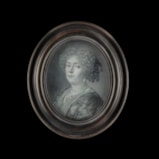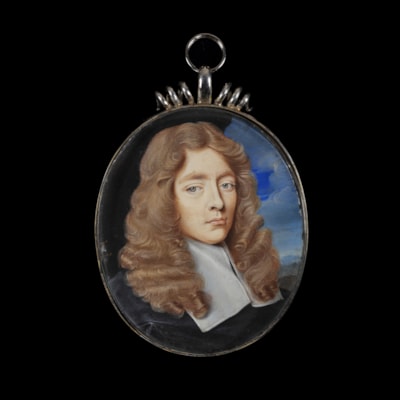Attributed to ROBERT NANTEUIL
(Circa 1623-1678)Portrait of a Noblewoman, possibly Anne-Marie d'Orléans Longueville, duchesse de Nemours (1625-1707), wearing floral embroidered ‘banyan’ over white gown, pearl necklace and large pearl earrings, her curled hair decorated with ribbons
Circa 1665
Black lead heightened with white on parchment
Oval, 63 mm (2 ¹/₂ inches) high
SOLD
As the premier portrait engraver of the 17th century, Robert Nanteuil established the format upon which French portrait prints for the next two centuries would be based, and elevated the status of engraving to a prestigious liberal art. In lieu of Nanteuil’s achievements, in 1660 King Louis XIV (1638-1715) granted a royal edict that gave engravers the privileges of other fine artists. His portraits were admired for the accuracy of their likeness and their striking vivacity, which he achieved with an extraordinarily refined technique. He was also skilled at capturing the character of his subjects, including the King.
Plumbago (graphite) portraits and engravings have always had a connection. Similar in precision, scale and subject, in the seventeenth and early eighteenth century, such drawings which were previously considered preparatory were promoted in importance and admired as finished portraits in their own right.[2] The exquisite detail shown in the present portrait, particularly in the clothing and hair, show how an astonishing array of textures could be conveyed in monochrome – a skill which Nanteuil certainly transferred to his engravings.
[1] For the most recent research on Nanteuil see Columbia University web page and exhibition: https://projects.mcah.columbia.edu/ma/2017/essay/robert-nanteuil-c-1623-1678-career-timeline
[2] This is discussed by Marjorie E. Wieseman in Perfect Likeness: European and American Portrait Miniatures from the Cincinnati Art Museum, New Haven and London: Yale University Press / Cincinnati Art Museum, 2006 and by Emma Rutherford, “The Plumbago Portrait in Britain”, in: Bernd Pappe, Juliane Schmieglitz-Otten and Gerrit Walczak (eds), European Portrait Miniatures. Artists, Functions and Collections, Petersberg 2014, pp. 157-66.

shipping notice
Worldwide shipping is included in all prices.
The Limner Company does not accept any responsibility for import duty, this is to be paid by the buyer.
Some stock items contain materials from endangered species which are governed by CITES regulations and will require a permit to export outside of Great Britain. If a certificate of export is required then this will be the responsibility of and paid for by the buyer .
you may also like













